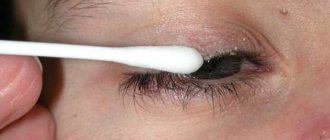What is conjunctivitis and is it contagious?
Conjunctivitis is a disease in which the conjunctiva, or connective membrane of the eye, becomes inflamed. They manifest themselves in symptoms such as itching, burning, lacrimation, photophobia.
There are other signs that depend on the form and type of the disease. Approximately 70% of people suffer from it. This is one of the most common ophthalmological diseases that occurs in both children and adults.
In this article
- Can you get conjunctivitis?
- How can you get infected with bacterial conjunctivitis?
- How contagious is conjunctivitis of viral etiology?
- Herpetic viral conjunctivitis
- How to avoid getting conjunctivitis from a patient?
What causes conjunctivitis, is the patient contagious to others, is the disease transmitted from one person to another, how can you avoid getting infected from a patient? To answer these popular questions for this topic, we need to take a closer look at the factors that provoke the disease. They can be combined into three large groups:
- pathogenic and opportunistic microorganisms - bacteria, fungi, chlamydia;
- viruses - herpes, adenovirus;
- allergens and other non-infectious factors.
Depending on the specific pathogen, inflammatory diseases of the conjunctiva are divided into bacterial, viral, fungal, chlamydial, angular, and allergic. Let's find out which conjunctivitis is contagious and which is not.
Allergic
The cause of this type of inflammation of the conjunctiva is contact with an allergen. Increased sensitivity of the body can develop to anything: food, pollen, animal hair, dust, medications. The disease does not pose any danger to others and cannot be transmitted from one person to another.
The disease manifests itself in the form of episodic burning and itching in the eyes, swelling of the eyelids, tearfulness, and increased reaction to light. In the mornings I am bothered by pathological discharge. Patients are also concerned about symptoms characteristic of acute viral infections: nasal congestion, runny nose, swelling of the nasopharynx.
Allergic conjunctivitis is not transmitted
Can you get conjunctivitis?
Allergic conjunctivitis is safe for others.
It arises as a result of the body’s perception of certain substances as hostile. Inflammation of the connective membrane occurs as a result of these irritants coming into contact directly with it. Allergens can be caused by a variety of factors. Most often they are animal hair, pollen, dust, contact lens solution, and medications. It is impossible to become infected with such conjunctivitis from another person. Other varieties of this disease are contagious.
Bacterial and viral inflammations are highly contagious. The first ones are transmitted through contact and household methods. The latter can also be infected through airborne droplets. Conjunctivitis, which develops during acute viral respiratory infections, is considered especially contagious. Let's take a closer look at these types of diseases.
Transmission routes
The mode of transmission of bacterial conjunctivitis is through household contact. However, chronic allergic disease is not transmitted from person to person.
Most often, a person himself introduces an infection to the mucous membrane, when, for example, he rubs his eyes with unwashed hands. Sometimes infection occurs without infection: the mucous membrane may contain pathogenic bacteria that are activated during a period of decreased immunity or after microtrauma.
How can you get infected with bacterial conjunctivitis?
How to distinguish this disease from other inflammatory lesions of the conjunctiva? Let us list the main symptoms of an infection that affects the connective membrane. Bacterial conjunctivitis occurs in both acute and chronic forms. In most cases, type 1 inflammation is diagnosed. It is characterized by the severity of symptoms. Inflammation develops first in one eye. He begins to itch and water. The patient feels as if a foreign body has gotten under the eyelids. There is pain in the eyeball. This is usually associated with increased sensitivity to bright light.
With staphylococcal conjunctivitis, mucus and pus are released from the eyes. The separated exudate has to be removed 6-8 times a day. The eyelids stick together in the morning and swell. Pneumococci cause inflammation, which is accompanied by severe itching and hemorrhages. They appear as red dots that are clearly visible on the conjunctiva. With gonococcal conjunctivitis, the connective tissue and eyelids swell so much that the eye closes completely.
A symptom specific to all types of bacterial conjunctivitis is a large amount of mucus and pus. These secretions contain bacteria. They may end up on a handkerchief, the patient’s hands, dishes, towels and any other objects. You can become infected with bacterial conjunctivitis by accidentally introducing germs to the conjunctiva. With such contagiousness, it is not surprising that after inflammation occurs in one eye, it subsequently spreads to the other.
Conjunctivitis in children: why is it so common?
Conjunctivitis is an inflammation of the mucous membrane of the eye, most often caused by an infection (viral, bacterial) or an allergic reaction.
The name of the disease comes from “conjunctiva” - this is the connective (mucous) membrane of the eye. It is transparent and in the form of a thin film covers the back surface of the eyelids and the front of the eyeball. Thus, the conjunctiva forms a sac, open in front in the area of the palpebral fissure. On the eyelids it is tightly fused with cartilage, and throughout the rest of the length it loosely connects with the underlying parts and smoothly passes into the cornea.
The places where the conjunctiva transitions from the eyelids to the eyeball are called the upper and lower fornix, which are reserve folds of the conjunctiva necessary for the movement of the eye and eyelids. There is also a semilunar fold of the conjunctiva, located in the area of the inner corner of the palpebral fissure and looks like a small pink lump.
Possessing a large number of vessels and sensitive nerve endings, the conjunctiva reacts violently to any irritation. This, as well as the fact that the conjunctiva, by its location, is easily accessible to all kinds of external influences, explains the high incidence of conjunctivitis.
In children, conjunctivitis occurs due to the immaturity of general and local immunity, due to the tenderness and vulnerability of eye tissue, as well as due to the behavior of small (and not so small) children, who introduce infection into the eyes through dirty hands. In some cases, the infection can also be spread by parents who, out of ignorance or absent-mindedness, having wiped the snotty nose of their crying child, wipe the tears from the child’s eyes with the same handkerchief.
According to the course, conjunctivitis can be divided into acute, subacute and chronic.
Due to the occurrence - bacterial, viral, allergic, fungal, parasitic and caused by the action of various physical and chemical factors.
According to the nature of the inflammatory process, conjunctivitis is divided into catarrhal (inflammation without pus), purulent, membranous and follicular.
Acute bacterial and viral conjunctivitis is most common in children. Recently, allergies have become quite common.
- With bacterial conjunctivitis, infection most often occurs through dirty hands and care items (towels, linen, toys). The causative agents of infection are staphylococci, streptococci, Escherichia coli, Haemophilus influenzae, pneumococci and so on. Usually the disease affects both eyes at once, but sometimes one eye is affected first, then the other.
— Viral conjunctivitis can be either separate (herpetic, epidemic hemorrhagic) or develop against the background of a disease caused by viruses and be one of its symptoms (adenoviral, chickenpox, measles). Usually one eye is affected first, and after two or three days the inflammation can spread to the second. In children, the most common cause is adenoviruses, which are infected by contact (through hands and underwear) or by airborne droplets.
— Allergic conjunctivitis is caused by an allergy to household allergens (house and library dust, animal hair and dander, etc.), pollen (plant pollen), as well as food and medications.
The chronic form of conjunctivitis occurs mainly in adults and is caused by long-acting irritants: smoke, dust, chemical impurities in the air. The cause of chronic conjunctivitis can also be vitamin deficiency, metabolic disorders, chronic lesions of the nose and lacrimal ducts.
Chronic conjunctivitis in children often occurs against the background of chronic diseases of the ENT organs - chronic tonsillitis, adenoiditis, sinusitis, and so on.
Is conjunctivitis contagious?
Infectious (bacterial and viral) conjunctivitis is easily transmitted. A child can become infected by taking a toy from a sick baby or simply by being in the same room with him.
Allergic conjunctivitis is not contagious.
Signs of acute conjunctivitis in children
Despite the fact that the causes of conjunctivitis may be different, the manifestations are almost always the same - redness, swelling of the conjunctiva of the eyelids and transitional folds, the presence of discharge from the eyes.
Acute conjunctivitis begins suddenly, first in one eye and then in the other eye. There is pain or pain in the eye, a sensation of a foreign body, redness of the conjunctiva, swelling and copious discharge. The conjunctiva becomes bright red and thickened. The color of the discharge varies from light to rich yellow-green. After sleep, the eyelids stick together, and there are purulent crusts on the eyelashes. A child may be irritated by bright lights. In children, the disease is often accompanied by general malaise, fever and headache.
Children often develop a filmy form of conjunctivitis, which is characterized, in addition to the usual symptoms, by the presence of a mucopurulent film on the mucous membrane, which can be easily removed with a cotton swab. Often the film separates spontaneously when the child cries.
The duration of acute conjunctivitis ranges from 5–6 days to 2–3 weeks or more.
The manifestations of allergic conjunctivitis differ from the manifestations of infectious:
— Usually both eyes are affected at once — Watery eyes — Itching — Swelling and redness of the eyelids
Signs of chronic conjunctivitis in children
Unlike acute conjunctivitis, chronic conjunctivitis is much less common and is characterized by a persistent and long-lasting course. Children complain of discomfort in the eye. The conjunctiva is slightly swollen and reddened, its surface has a velvety appearance.
When to see a doctor?
Conjunctivitis in children is a serious disease, self-medication of which can lead to dire consequences. It is impossible to cure conjunctivitis only by washing your eyes with tea! At the slightest sign of inflammation of the mucous membrane, you should immediately consult a doctor who will prescribe appropriate treatment, since conjunctivitis can be complicated by the transition of the inflammatory process to the cornea, which can cause visual impairment.
Moreover, there are other serious eye diseases that may outwardly look like conjunctivitis. Allergic conjunctivitis requires mandatory consultation with an allergist.
If inflammation persists in one eye, a foreign body may have entered the eye!
How contagious is conjunctivitis of viral etiology?
Viral conjunctivitis can be caused by various factors. Common causative agents of this disease are adenoviruses and herpes. Inflammation of the conjunctiva during these infections develops as a secondary disease. In this regard, the first signs begin to appear only 7-10 days after the virus enters the body. Adenoviral conjunctivitis is the most contagious type of the disease. You can become infected by being in the same room with a sick person and breathing the same air.
Primary symptoms of infection:
- general weakness;
- drowsiness;
- fever and chills;
- cough;
- runny nose;
- headache.
These signs are typical for any ARVI. After a few days or a week, symptoms of conjunctivitis appear. The patient begins to complain of itching and burning in the eyes. They water a lot, itch, and react painfully to light. First, inflammation affects one eyeball. It is quite difficult to avoid infection of the second one. The disease spreads especially quickly in children. They rub their eyes with their hands and lead to the development of bilateral inflammation. The source of infection is any object that the infected person has come into contact with. Even after recovery, it may remain contagious for several days.
First symptoms of infection
After the incubation period is completed, the first clinical symptoms begin to appear, which will lead the patient to suspect the disease:
- malaise (weakness, fatigue, drowsiness);
- headache, muscle aches when the viral agent spreads throughout the body;
- slight redness of the eyes;
- discharge of yellowish exudate from the inner corners of the eyes, which prevents them from opening in the morning;
- itching, burning, pain, which are especially pronounced in the morning, as pathogenic microorganisms multiply intensively during the night;
- a slight increase in body temperature, which occurs rarely.
If treatment is not carried out at this stage, clinical symptoms worsen. The redness of the eyes develops significantly, and small hemorrhages on the surface of the cornea are possible. The eyes become swollen and inflamed. There is a feeling of a foreign object under the eyelids.
Herpetic viral conjunctivitis
Herpes is also highly contagious. Some people believe that this virus is only transmitted through sexual contact. However, it is not. You can also become infected with herpes through a handshake. It is also transmitted by airborne droplets. Penetrates the body through the mucous membranes of the oral cavity or upper respiratory tract, passes through tissue, enters the blood, lymph and various internal organs.
As a result, herpes is integrated into the genetic apparatus of nerve cells, after which it is no longer possible to remove it from the body. The virus manifests itself during hypothermia or overheating, that is, at a time when the immune system is more vulnerable. A distinctive symptom of the pathology is the presence of blisters on the skin, lips, and eyelids. Viral herpetic conjunctivitis is accompanied by lacrimation, itching, swelling of the eyelids and conjunctiva. In the first days of illness, these signs cause particular discomfort. It is absolutely forbidden to scratch itchy eyelids. Because of this, the bubbles only become larger. In addition, you risk introducing an infection into the second eye.
conclusions
Now you know how to treat recurrent conjunctivitis and how you can minimize the risk of its recurrence. Follow the rules of visual hygiene and medical recommendations, and you will not have to deal with the consequences of this unpleasant disease! I wish you good health and clear vision, dear readers!
Feel free to leave comments and ask questions! Sincerely, Olga Morozova.
Inflammation of the mucous membrane of the eyes, called conjunctivitis, is familiar to absolutely everyone. The disease is especially common in children's groups, but adults can also become infected with it. How the disease is transmitted depends on its form.
The content of the article
How is conjunctivitis treated?
So, except for allergic conjunctivitis, all other varieties of this disease are contagious, especially viral infections. This means that it is necessary to take a responsible approach to treatment. Many continue to go to work or school, which poses a risk of infecting other people. Such infections spread quite quickly in children's educational institutions.
Children in schools and kindergartens are constantly in contact with each other. However, they usually do not follow hygiene rules. As a result, entire groups and classes are closed for quarantine. Adults should also take sick leave. The contagiousness of the disease is not the only reason that should force treatment. Conjunctivitis can lead to the development of complications, the transition from acute to chronic, and the emergence of other ophthalmopathologies.
Let us list the basic and general principles of therapy for all types of conjunctivitis. During diagnosis, it is important to establish the exact cause of inflammation, that is, the specific pathogen. If it is bacteria, antibacterial drugs are prescribed. For viral conjunctivitis, you need to take antiviral medications. They are prescribed in tablets, drops and ointments. Drug treatment is aimed primarily at eliminating or suppressing the causative agent of the disease. Symptoms can be relieved with moisturizing drops such as Systane and Artificial Tear. Despite the fact that such solutions have no contraindications or side effects and are available in pharmacies without a prescription, it is not recommended to use them without consulting a doctor.
In the treatment of conjunctivitis, folk remedies can also be used. They must also be approved by a specialist. Doctors usually recommend making lotions from decoctions made from chamomile, celandine, and eyebright to eliminate swelling and itching. Great attention should be paid to hygiene rules.
How to prevent recurrence of eye disease?
To avoid recurrence of conjunctivitis, it is important to follow these rules:
- Avoid touching your face with dirty hands.
- Change your pillowcase daily for 2-3 weeks after the symptoms of conjunctivitis disappear.
- To wash the organs of vision, use different cotton swabs.
- During the treatment of conjunctivitis, instill medications in both organs of vision, even if signs of pathology are present in only one.
- You can prevent relapse of conjunctivitis in very young children by wearing undershirts with closed sleeves or gloves made of cotton fabric. If this does not help, parents should ensure that they always have antihistamines on hand to relieve the itching.
How to avoid getting conjunctivitis from a patient?
Healthy people in the apartment should have as little contact as possible with the sick person. However, when treating a sick child, it is difficult to avoid contact. You need to take care of him, help wash his eyes, drop drops, apply ointments. However, it is still necessary to allocate a separate room for it. Also, to prevent it from infecting others, it is recommended:
- buy the patient disposable tableware and handkerchiefs, which after use must be put into bags and thrown away;
- prepare a separate towel for the patient, which must be washed daily;
- move his toothbrush away from others;
- wash your hands with soap several times a day, especially after visiting the sick room;
- Boil pipettes and ointment sticks daily;
- ventilate the apartment at least twice a day;
- do daily wet cleaning of the premises;
- take vitamins to strengthen the immune system.
After the patient has recovered, you need to thoroughly clean the house, wash all the dishes, boil bedding and clothes. If you were wearing scheduled replacement contact lenses before getting sick, you should throw them away and buy a new pair. All these measures must be taken when treating an adult. It is important to complete the full course of therapy. Symptoms of the disease may disappear after a few days, but this does not mean that it has gone away completely. So, with viral conjunctivitis, even after complete recovery, a person can still be a carrier of the infection. If treatment is not completed, the risk of complications increases many times over.











